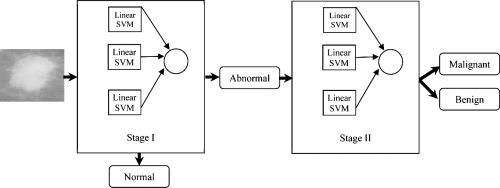IRBM ( IF 4.8 ) Pub Date : 2020-01-31 , DOI: 10.1016/j.irbm.2020.01.005 H. Samma , B. Lahasan

|
Objectives
Mammography mass recognition is considered as a very challenge pattern recognition problem due to the high similarity between normal and abnormal masses. Therefore, the main objective of this study is to develop an efficient and optimized two-stage recognition model to tackle this recognition task.
Material and methods
Basically, the developed recognition model combines an ensemble of linear Support Vector Machine (SVM) classifiers with a Reinforcement Learning-based Memetic Particle Swarm Optimizer (RLMPSO) as RLMPSO-SVM recognition model. RLMPSO is used to construct a two-stage of an ensemble of linear SVM classifiers by performing simultaneous SVM parameters tuning, features selection, and training instances selection. The first stage of RLMPSO-SVM recognition model is responsible about recognizing the input ROI mammography masses as normal or abnormal mass pattern. Meanwhile, the second stage of RLMPSO-SVM model used to perform further recognition for abnormal ROIs as malignant or benign masses. In order to evaluate the effectiveness of RLMPSO-SVM, a total of 1187 normal ROIs, 111 malignant ROIs, and 135 benign ROIs were randomly selected from DDSM database images.
Results
Reported results indicated that RLMPSO-SVM model was able to achieve performances of 97.57% sensitivity rate with 97.86% specificity rate for normal vs. abnormal recognition cases. For malignant vs. benign recognition performance it was reported of 97.81% sensitivity rate with 96.92% specificity rate.
Conclusion
Reported results indicated that RLMPSO-SVM recognition model is an effective tool that could assist the radiologist during the diagnosis of the presented abnormalities in mammography images. The outcomes indicated that RLMPSO-SVM significantly outperformed various SVM-based models as well as other variants of computational intelligence models including multi-layer perceptron, naive Bayes classifier, and k-nearest neighbor.
中文翻译:

用于乳腺X线摄影质量识别的优化的两阶段集成模型
目标
由于正常肿块和异常肿块之间的高度相似性,因此乳房X射线照片的肿块识别被认为是一个非常具有挑战性的模式识别问题。因此,本研究的主要目的是开发一种有效且优化的两阶段识别模型来解决该识别任务。
材料与方法
基本上,开发的识别模型将线性支持向量机(SVM)分类器与基于强化学习的模因粒子群优化器(RLMPSO)结合起来,作为RLMPSO-SVM识别模型。RLMPSO用于通过同时执行SVM参数调整,特征选择和训练实例选择来构造线性SVM分类器的两阶段集合。RLMPSO-SVM识别模型的第一阶段负责将输入的ROI乳腺摄影肿块识别为正常或异常肿块模式。同时,RLMPSO-SVM模型的第二阶段用于进一步识别异常ROI为恶性或良性肿块。为了评估RLMPSO-SVM的有效性,共有1187个正常ROI,111个恶性ROI,
结果
报告的结果表明,RLMPSO-SVM模型在正常与异常识别情况下能够实现97.57%的灵敏度和97.86%的特异性。对于恶性与良性识别性能,据报道灵敏度率为97.81%,特异性率为96.92%。
结论
报告的结果表明,RLMPSO-SVM识别模型是一种有效的工具,可以帮助放射科医生诊断乳房X线照片中出现的异常。结果表明,RLMPSO-SVM明显优于各种基于SVM的模型以及其他各种计算智能模型的变体,包括多层感知器,朴素贝叶斯分类器和k近邻。



























 京公网安备 11010802027423号
京公网安备 11010802027423号